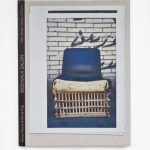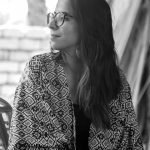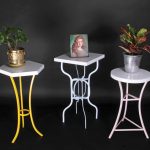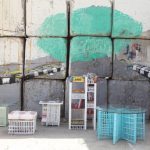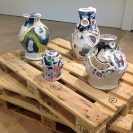“I believe that the copy/paste syndrome is an essential part of contemporary aesthetics and creative processes,” she began, “I would actually go further following the 19th century sociologist Gabriel Tarde who considered all kind of creations as small variations or improvisations on established and repeated patterns. Tarde wrote that: ‘Invention is always, by its very nature, an intersection of imitation rays, an original combination of imitations’. In that sense the Copy/Paste is not a recent syndrome. It’s a constant condition.”
Wise words from the incredible creator and guest speaker/lecturer at the 2015 Nuqat Creative Conference, Manar Moursi – founder of Studio Meem and co-author to Sidewalk Salon. We got the opportunity to sit down and chat with Manar to find out all about the politicizing of chairs, her baby – Studio Meem – and what she’ll be touching on in the conference.
In your opinion, what makes a creative?
I’m going to borrow an expression from Nicolas Bourriaud’s Postproduction book – a contemporary creative is a DJ of sorts – mixing different tracks, inspirations and influences. The ingenuity comes in making the combination that fits its context well.
How do politics relate to architecture and what politicizes a chair?
Generally, chairs raise questions such as: who can occupy the public space of the city? The answers to this question are inherently political since they depend on the reaction of the authorities. In a context marked by a proliferation of informal economical activities and a lack of formal public spaces, the occupation of the sidewalks with chairs can be seen as a kind of guerrilla strategy by informal vendors, small entrepreneurs or residents of their areas. This can be either tolerated or curbed by the authorities. It’s like a game of cat and mouse. For example, earlier this year, authorities closed down many of the cafés of the downtown district of Borsa as part of an overall plan to upgrade and gentrify the downtown area of Cairo, a move that reflects the current government’s discourse to control public spaces, at least in the city center.
What is Studio Meem’s main focus and how do you see it evolving?
Studio Meem is my laboratory to experiment and research projects on the city – from product design to architecture to projects in public space to writing on and photographing the city.
Since its founding I’ve really been lucky to work on different scales of intervention in the city.
I see Studio Meem as constantly evolving with the pace of changes I see around me and the possibilities of making new work or not – as I find myself working in phases – cycles where the work is more research based projects vs. projects that are published, built and constructed.
Sidewalk Salon is such an interesting study of seating in a city heavily invested in chairs – what drew you to the subject?
My partner in the project David Puig and I started documenting street chairs of Cairo around 4 years ago. We felt that the chairs were the perfect zoom and wide-angle lens with which to view the city. They unraveled sociological and urban aspects of the city that we felt could be interesting to share. We were attracted by their widespread abundance on the one hand, and by their singularity on the other hand.
Then there is their character and their design. The streets chairs of Cairo bear the particular charm of imperfection. Their appeal lies in the way in which the passage of time and the interventions of their owners to reverse it —fixing and decorating them with the resources at hand—have made each of them unique. They are old and worn out, yet startlingly fresh and appealing. With its ability to digest the objects that land on its streets and make them unique in the process, Cairo can be seen as one huge, customizing factory that transforms mass-produced chairs into individual characters. Chairs are more than pieces of wood, plastic or metal assembled to defy gravity: they carry memories, scars and personal signatures on their bodies. They project the attention they have been granted, becoming indirect portraits of their owners.
And finally, we understood we could talk about Cairo though those chairs. We could not only tell the stories of the people who sit on them, but also talk about some of the urban and social dynamics of one of the biggest cities of the world. The philosopher Gaston Bachelard wrote in one of his books: “The minuscule, a narrow gate, opens up an entire world.” In our case, chairs were that modest, overlooked element of reality that allowed us to talk about broader issues and problems.
Equipped with Polaroid cameras and sound recorders, we assumed the role of “sidewalk botanists” and experienced what the Japanese artist Akasegawa Genpei described as “the fun of looking at reality instead of doing it all in your head”.
Through your line of work and expertise, does said syndrome affect your creative process?
I think the Studio’s product line Off the Gireed really highlights the copy-paste syndrome with the processes involved in its production. As I mentioned earlier, it was a product line that was inspired by the use of these very ubiquitous crates on the streets of Cairo. One can say, in my DJ mixtape, I took from the street vendors and their innovative use of the crate and just added a layer I saw in other products that were using recycled elements in their design. To add another layer to all this, was the innovation of the craftsmen I worked with. I am a big believer of the Japanese values of “egoless craftsmanship” which believe that the beauty of crafts come from the repetition of the work, from the production and the obstacles you meet when you are producing. This was definitely very true in the processes of making Off the Gireed.
What would you be touching on in the conference and what should people expect?
David and I will explore the copy-paste theme in relation to the urban spaces of the city of Cairo and to our book Sidewalk Salon: 1001 Street Chairs of Cairo. The works of two intellectuals, one from the 19th century, Gabriel Tarde, and one contemporary, Nicolas Bourriaud, will provide us with the language and images of this endeavor.
With the very original dialectic of Imitation / Innovation developed by Gabriel Tarde (1843-1904) we will try to explain what constitute a recognizable urban landscape, constant in its defining lines, shapes, objects and colors, but at the same time perpetually in motion thanks to the molecular interventions that citizens create on a daily basis. At the street level what differentiates one city from another? Why are some elements and patterns repeated ad infinitum in an urban space? How do those patterns and interventions come to be? How are new patterns and actions introduced and spread through the city like Chinese whispers? To answers these questions and illustrate these ideas we will provide examples from the research we conducted to produce Sidewalk Salon.
With the works of Nicolas Bourriaud we will go into a more self-reflective direction. We will try to explain how an art project and in our particular case Sidewalk Salon, produced “singularity and meaning” from a “chaotic mass of objects…that constitute our daily life”. While copy-pasting chairs from the streets of Cairo into the pages of a book, how do we create a broader reflection on the capital of Egypt which aims to trigger questions valid for anyone interested in the urban condition today? How do we reorganize, edit, and mix up the materials collected from everyday life to generate emotions, ideas and meaning?
For more information on Studio Meem and Sidewalk Salon, check them out at www.studiomeem.me, www.1001streetchairscairo.com, and www.sidewalksaloncairo.com. Follow them on Twitter @studio_meem and @1001chairscairo and on Facebook: StudioMeemCairo and 1001StreetChairsCairo.




